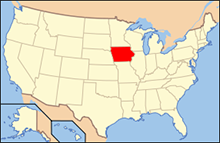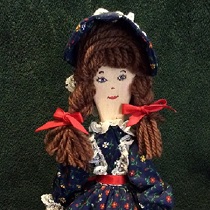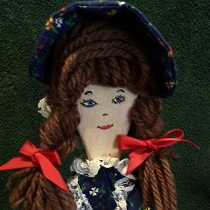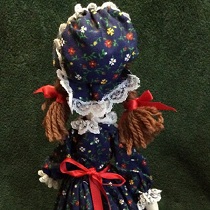Description of Figure/Doll
This pioneer doll is made with a wooden spoon as the face. Her facial features are drawn on the wooden spoon. She has brown yarn for hair. Her body is handmade with stuffed cotton cloth. She has white lace accents on her dress and bonnet and red ribbons on her hair and waist.
Link to higher resolution images at ClipPix
USA: Iowa
Location: Midwest USA
Capital: Des Moines
Main language: English
Currency: US Dollar
Figure/Doll
Construction: Wood spoon, cotton
Height in Centimeters: 30
Height in Inches: 12


Heroine from Iowa: Kate Shelley Saves a Passenger Train from Disaster
Reading Level: 6.50
My name is Kate Shelley and I grew up in Iowa. I will tell you the story of how I became famous when I was only 15 years old. There is even a bridge named after me!
I was born in Ireland, but my parents moved to the United States when I was only a year old. We lived on a small farm near some railroad tracks. In fact, my dad’s job was to build and maintain tracks for the railroad company. He worked very hard and finally became foreman. However, when I was 12 years old, my dad died. Since I was the oldest of 6 kids, I had to help support the family. I worked hard planting and harvesting crops, as well as cooking and cleaning in the house.
Our farm was very close to a small creek, called Honey Creek. The creek was deep and there was a short railroad bridge over it. Every day, we would watch trains going over the creek on their way to and from cities east (like Chicago, Illinois) and cities west (like Omaha, Nebraska). I soon learned all the train schedules. I knew exactly when the large Chicago and North West Railway would bring hundreds of people past our property. For example, I knew that every Sunday night a train would come from the west, headed toward Chicago. It would first stop in Des Moines at the Moingona Train Station. Then, it would cross the large railroad bridge over the raging Des Moines River. A short distance later, I would see it crossing the smaller bridge over Honey Creek. Remember, back is 1880, there were no cars and most people traveled via train or horse.
Late one Wednesday evening (July 6, 1881), a horrendous thunderstorm occurred in our area. I did not realize it at the time, but the heavy rain and winds washed out the Honey Creek bridge. At 11:00 pm, an explosive crash of the bridge suddenly woke me up. I looked out the window and could not believe what I saw and heard. When the lightening lit the sky, I could see that the bridge had collapsed. I could also hear men screaming for help. I quickly grabbed a lantern and ran to the creek. Once there, I could see that a small locomotive had been sent out to check the condition of the bridges (Des Moines and Honey Creek). When it got to Honey Creek, the locomotive and the four men in it crashed into the rushing water. Two of the men were killed and the other two were clinging to branches.
Since I knew the train schedules, I quickly realized that in about an hour a large passenger train would be coming from Omaha to cross the Des Moines Bridge, and then the Honey Creek Bridge. I yelled down to the two men, “Hang on! I will go get help from the station. I also need to make sure the passenger train is warned not to come here.”
Without thinking about the risk, I knew that I had to alert the train before it left the Moingona station at midnight. There were no telephones or electronic signals to alert the station. The only way to get there was to cross the high Des Moines River bridge. I knew I would have to walk. Also, the Des Moines railroad bridge had a wooden supporting trestle, but the “bridge” part consisted of only rails and ties. In other words, to walk across, one would have to walk on the rails (like a balance beam). Since it was dark and very windy, my only choice was to literally crawl on hands and knees across the bridge. What made it even more dangerous was that there were no lights, and my lantern had blown out. My only light was from the periodic lightning strikes. I was scared, cold and completely soaked from rain. But I knew I had to keep going to warn the next train and to get help for the two men in the creek.
After I crawled across the bridge, I still had to walk 2 more miles to get to the station. When I arrived at the station, my knees were bleeding and I was exhausted. I had just enough energy to tell the station manager that he had to stop the passenger train and go save the two men in the creek.
Thanks to my bravery and quick thinking that night, over 200 passengers on the passenger train were safe. In addition, the two men in Honey Creek were rescued. As a reward, the Chicago and North Western Railway gave me $100, a half barrel of flour, half a load of coal, and a lifetime pass. Very quickly, the story spread, and I became quite famous. Songs and newspaper articles were written about me, Several years later, a new bridge over the Des Moines river was named after me. The Kate Shelley Bridge proudly stands 190 feet above the Des Moines River. It has double tracks so two trains can cross at the same time!






